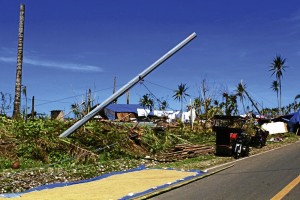Cut-and-paste risk management
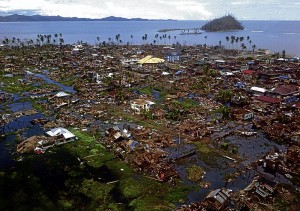
BOSTON town is in ruins after Typhoon “Pablo” made landfall in Davao Oriental on Dec. 4 with gusts of 210 kilometers per hour. REY MARFIL/CONTRIBUTOR
“You get tragedy where the tree, instead of bending, breaks.”
–Ludwig Wittgenstein
The statement of the Austrian philosopher comes to mind during conversations among Mandaya and Dibabawon coconut farmers from Monkayo, Compostela Valley, who were severely affected by Typhoon “Pablo.”
They were describing how their “typhoon-insensitive” coconut trees, in contrast to those found in the Bicol region, had not learned to dance and sway with the wind, hence they broke from the storm’s onslaught.
Mandaya tribesmen in Davao Oriental, meanwhile, were having a bellyful of laughs after hearing that their local executives had been consistently awarded with the “Gawad Kalasag” for being the best prepared in disaster-risk reduction and management by the Regional Risk Reduction and Management Council, and the Office of Civil Defense. Kalasag means shield.
In the midst of all the death and destruction from the monster typhoon, indigenous peoples and their fellow upland settlers can still crack jokes and erupt in laughter. It underscores the resilience in spirit, if not in body, of the poor and vulnerable in these southern villages.
They found blessings over the fact that the typhoon hit during daytime and that most of their relatives had not yet returned to their hometowns to celebrate the Christmas and New Year
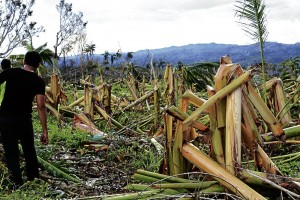
PABLO’S winds destroyed local varieties of banana in Monkayo, Compostela Valley. PHOTO BY JORGE GOLLE, AFRIM
holidays.
Agricultural tragedy
Their relatives will be returning to an unrecognizable landscape. Pablo’s devastating effects on the region’s agricultural production and trade are unmistakable in the imagery of coconut trees broken in half, banana plantations leveled to the ground, unripe mango and mangosteen fruits hanging from fallen trees, and rice and corn farms buried under tons of mud and debris.
Data from the Department of Agriculture (DA) a week after the catastrophe showed that more than 34,000 hectares of corn and a little less than 7,000 ha of rice were damaged by the typhoon. Losses incurred by the rice and corn farms were estimated at P1.6 billion.
Combining this figure with the P415 million lost in the poultry and livestock sectors brings the total damage to these sectors to P2 billion.
The coconut industry also suffered huge losses. Seventy-five percent of its P766 million in losses can no longer be recovered in the next five to six years unless a massive replanting program is undertaken in the coconut sector.
Export crop destroyed
Fermin Adriano, a World Bank consultant, pointed out the grave and immediate effects of the calamity on strategic export crops such as banana.
“It will take a year before they recover. And after they recover the problem will be the potential loss of markets that will seek their supplies elsewhere,” he said.
Adriano acknowledged the tragic impact on the food and incomes of banana farmers who used to earn P15,000 to P20,000 a month. “With no production and little food crops grown by these farmers, the big problem is how to meet their needs in the next twelve months,” he said.
Close to 14,853 ha, farmed mostly by small banana growers in the Davao region, were severely affected by the typhoon, reported the Pilipino Banana Growers and Exporters Association.
The association placed the revenue losses from these farms at P8.3 billion. The destruction will also require P7.5 billion in new investments to enable affected growers to begin anew.
Jun Blanco, a representative to the Indigenous Peoples (IP) Council of Compostela Valley and a small coconut and banana grower himself, said that 60 to 70 percent of economic activity in the town of Compostela was from banana-growing contracts.
Thousands lose wages
Until now he cannot fathom how small growers can begin to pick up the pieces from the complete devastation of their farms. On the labor front alone, about 5,000 households, which are dependent on wages as farm laborers, will have no incomes this Christmas.
The industry’s contribution to the local economy alone is pegged at about P22 million a month. The challenge is beyond relief and humanitarian assistance as the massive destruction of livelihoods will be felt by ordinary people and will continue to reverberate in all aspects of the region’s life in the years to come.
The disaster’s effects will linger long after any meaningful relief and rehabilitation activity is implemented in farming areas because of the destruction in critical infrastructure, according to the Mindanao Business Council.
The DA said damage to irrigation infrastructure was more than P1 billion, and damage to fishponds and related fishing equipment and facilities was more than P33 million.
Typhoon-free discourse
The Alternate Forum on Research in Mindanao (Afrim) pointed to the more serious effects of the disaster on the “typhoon-free” language and discourse often used to entice agribusiness and fisheries investors to Mindanao.
The notion that the island remains typhoon-free has been demolished and will likely dampen investor interest in the agribusiness and fisheries sector in the next few years, Afrim noted in its post-disaster analysis.
This will have a short- and medium-term effect on the country’s agricultural exports since banana and coconut are among the chief sources of export revenues.
The DA has come up with a conservative estimate of nearly P12 billion in losses due to the typhoon, and the numbers will continue to grow as government officials begin the tedious task of measuring actual declines in output.
Few people are buying into current estimates and are neither convinced that the typhoon is the sole reason for the destructive effects of the disaster.
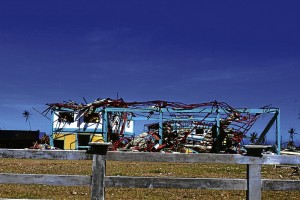
THE MUNICIPAL gymnasium could not provide a haven for refugees in Cateel, Davao Oriental. PHOTO BY JORGE GOLLE, AFRIM
Mining, deforestation
The effects of unregulated mining and deforestation of critical watersheds on the destructive capacity of the storm were vividly seen in the falling logs that killed people and destroyed properties, and the frightening flow of mud, rock and gravel from upland areas made weak by years of unregulated mining, quarrying and charcoal-making.
Yet, none of these can match the governance issues that are hidden behind the oft-repeated excuses for calamities and tragedies in the countryside.
Cut-and-paste responses
There are lessons to be learned from how the disaster-risk reduction and management (DRRM) industry has grown by leaps and bounds with few credible signs of mitigating the vulnerability of poor and climate-insecure inhabitants in areas outside Metro Manila.
The failure to change practices is an indictment of the performance of both State and non-State actors. It will linger long after the immediate harmful effects of the typhoon have been addressed.
The central research question, Afrim argues, is why local executives, settlers and indigenous communities were so unprepared for the disaster despite early announcements and the awards in disaster-risk reduction and management planning bestowed upon local governments by regional and national agencies.
Mindanao scholar Rufa Guiam questions the recognition awarded to local executives by exposing how more than half of the municipalities she surveyed in a recent DRRM study of Mindanao showed cut-and-paste copies of DRRM plans that they quickly accomplished because the release of internal revenue allotments (IRA) was hinged on this requirement.
“Some of the DRRM plans were copied so well that the names of the original municipalities where they were copied from were still contained in the plans,” she says.
Maps, GPS unused
Guiam adds that the DRRM plans were so poorly adopted and understood by local executives that the maps that accompanied them could not be explained and propagated among those in need of the information. GPS facilities were unused by those who were granted these equipment.
Shirley Iguanon, National Commission on Indigenous Peoples (NCIP) officer of Compostela Valley, also bemoans the lack of recognition of the rights of indigenous peoples to be consulted in the formulation and implementation of risk reduction and relief, and rehabilitation programs.
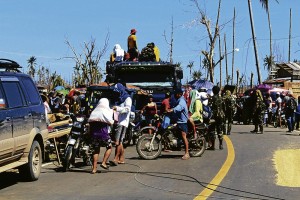
RELIEF convoys are escorted by security forces to prevent violent conflict among refugees. PHOTO BY JORGE GOLLE, AFRIM
“Pablo is unlike (Tropical Storm) ‘Sendong.’ This time, the majority of the areas hit in Compostela Valley are ancestral domains of IPs. We all need to be more sensitive to the rights of IPs and enable them to participate.” Iguanon says.
Unrecorded IPs
IP communities can be found in the remotest places and this isolation is not just geographical. Most are still unrecorded and thus, not all have access to basic services and humanitarian aid because they would not be in official data and statistics, even at the village level.
“The problem goes much deeper. It is time to study the effects of decentralization and devolution on the effectiveness of DA, DENR (Department of Environment and Natural Resources) and DILG (Department of the Interior and Local Government) climate-change operations at ground level,” says Francisco Lara, International Alert country director.
Lara explains that the risk-monitoring and risk-reduction initiatives of many local government offices are being performed by people who got their posts through kinship ties and alliances with local politicians rather than their knowledge and expertise.
Open secret
It is an open secret among higher-ups in the agriculture bureaucracy that the monitoring practices that were such an important feature of disaster preparedness in the past has been weakened by the diminished flow of reliable information from the periphery to the center following the decentralization of functions in the 1990s.
Critical changes also need to be put in place in disaster-risk management. Pablo showed how people unaccustomed to the ferocity of Pacific Ocean storms can treat these warnings lightly after perceiving no threatening signs 24 to 48 hours after the announcements were made.
Mindanao-based social psychologist Gail Ilagan proposes that future evacuation strategies include provisions for securing food and animal possessions of refugees since concern over their few remaining assets was often the most important consideration for their refusal to evacuate.
Politics of IRA release
It is clear that Pablo is not the only source of dislocation and tragedy. The politics of disaster-risk response and management bears equal responsibility for magnifying the scale of the tragedy.
Bringing politics back requires that policymakers, local executives and aid agencies place more emphasis on reliable and effective application of DRRM capacities.
Tying IRA releases to DRRM accomplishments has politicized the process to the extent that DRRM planning is seen as a one-off activity instead of a constant engagement.
Conflict-sensitive planning must also be inserted in DRRM-related activities as seen in the potential rise in incidents of horizontal violence and conflict as local inhabitants fight over scarce relief and rehabilitation budgets.
Aid convoys are now accompanied by fully armed security forces after violence erupted in areas where relief supplies were blocked by hungry and irate lowland inhabitants. The blockade deprived upland villages of relief assistance.
Lost markers, violence
The worst may yet come. The loss of boundary markers and the already insecure property rights in areas hit by the disaster looms large as a future trigger of violent conflict in the communities adversely affected by the calamity.
Violent conflict will erupt unless the government’s rural line agencies work together quickly to restore the land and resource claims of those affected by the calamity.
Humor, generosity
Undoubtedly, the Filipino capacity for humor and generosity has not been lost despite the tragedy. In the midst of danger and destruction, a tribal leader who received a call from the Comval NCIP office traveled all the way to the town of Nabunturan carrying three live chickens.
She crossed rivers and traveled on foot to reach the town proper. She came to the NCIP office lugging the chickens as her contribution to the relief effort.
A banana grower on a truck laden with local varieties of banana harvested from his farm diverted his produce to Monkayo to feed the hungry instead of making a profit.
These small acts of kindness were evident everywhere. As Pablo recedes in the popular consciousness and figures less and less in the accounting of responsibility for the scale of the tragedy, so are people proving that collective action strategies will be required to stem future tragedies.
(Nikki de la Rosa, who holds degrees from the University of the Philippines and the London School of Economics, is Mindanao program manager of International Alert. She supervises a European Union-funded capacity-building project among indigenous peoples and local government units in provinces affected by Typhoon “Pablo” in eastern Mindanao.)
By the numbers
Death toll: 1,047 (692 identified, 355 unidentified)
Missing: 841
Houses destroyed: 66,469
Houses damaged: 101,758
Damage to agriculture, infrastructure and property: P32 billion
Compiled by Inquirer Research
Sources: NDRRMC Situation Report (as of Dec. 20) AND NEDA











